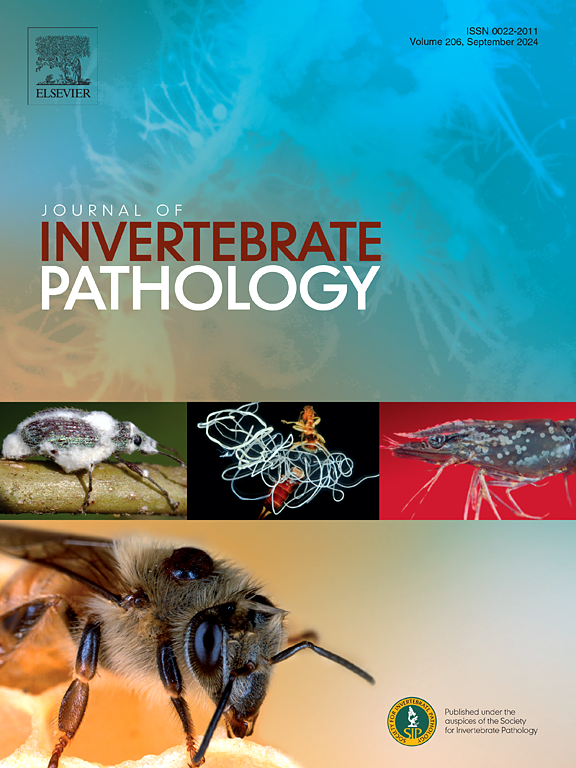Rational protein design to improve the thermal stability of a Bacillus thuringiensis Vip3A protein
IF 2.4
3区 生物学
Q1 ZOOLOGY
引用次数: 0
Abstract
Vip3A proteins produced by the Bacillus thuringiensis bacterium exhibit insecticidal activity against various crop-damaging lepidopteran pests. However, their limited thermal stability and short shelf life render them unsuitable for use as biopesticides. In this study, we employed rational protein design to enhance the thermal stability of Vip3A64 while minimizing its negative impact on insecticidal activity. This involves substituting potential amino acids based on structural data and using a computational tool (HoTMuSiC) to predict the effect of mutations on the protein’s thermal stability as defined by the melting temperature (Tm). We then introduced eight single amino acid substitutions (V239T, V320K, A351C, A351F, D621I, N633Y, E754W, and Q771I) into the tetrameric core and solvent-exposed domains of Vip3Aa64. As determined by the protein thermal shift (PTS) assays, the N633Y and V239T mutants exhibit higher protein melting temperatures than those of the wild type, indicating their enhanced thermal stability. In contrast to other mutants, V239T and N633Y retained their insecticidal activity after one hour of exposure to the high temperature of 55 ˚C. Furthermore, after one month of storage at 37 ˚C, N633Y was the only mutant capable of killing Spodoptera exigua larvae, indicating that it is more stable than the other mutants and the wild type. This study highlights the potential of rational protein design to improve thermal stability and provides a framework for developing effective insecticidal proteins for sustainable agriculture.

合理设计蛋白以提高苏云金芽孢杆菌Vip3A蛋白的热稳定性
苏云金芽孢杆菌产生的Vip3A蛋白对多种危害作物的鳞翅目害虫具有杀虫活性。然而,它们有限的热稳定性和较短的保质期使它们不适合用作生物农药。在本研究中,我们通过合理的蛋白设计来提高Vip3A64的热稳定性,同时尽量减少其对杀虫活性的负面影响。这包括根据结构数据替换潜在的氨基酸,并使用计算工具(HoTMuSiC)来预测突变对蛋白质热稳定性的影响,该蛋白质的热稳定性由熔化温度(Tm)定义。然后在Vip3Aa64的四聚体核心和溶剂暴露结构域中引入8个单氨基酸取代(V239T、V320K、A351C、A351F、D621I、N633Y、E754W和Q771I)。通过蛋白质热移(PTS)测定,N633Y和V239T突变体比野生型表现出更高的蛋白质熔化温度,表明它们的热稳定性增强。与其他突变体相比,V239T和N633Y在55˚C高温下暴露1小时后仍保持杀虫活性。此外,在37℃条件下保存1个月后,N633Y是唯一能够杀死夜蛾幼虫的突变体,表明其比其他突变体和野生型更稳定。该研究强调了合理设计蛋白质以提高热稳定性的潜力,并为可持续农业开发有效的杀虫蛋白质提供了框架。
本文章由计算机程序翻译,如有差异,请以英文原文为准。
求助全文
约1分钟内获得全文
求助全文
来源期刊
CiteScore
6.10
自引率
5.90%
发文量
94
审稿时长
1 months
期刊介绍:
The Journal of Invertebrate Pathology presents original research articles and notes on the induction and pathogenesis of diseases of invertebrates, including the suppression of diseases in beneficial species, and the use of diseases in controlling undesirable species. In addition, the journal publishes the results of physiological, morphological, genetic, immunological and ecological studies as related to the etiologic agents of diseases of invertebrates.
The Journal of Invertebrate Pathology is the adopted journal of the Society for Invertebrate Pathology, and is available to SIP members at a special reduced price.

 求助内容:
求助内容: 应助结果提醒方式:
应助结果提醒方式:


